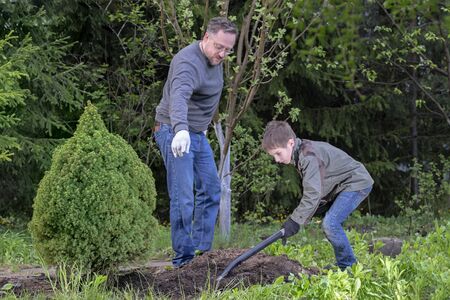Understanding Lawn Dormancy
As the temperatures drop and daylight hours shorten, many homeowners notice their once-vibrant green lawn starting to turn brown or yellow. Don’t worry—this doesn’t necessarily mean your grass is dying. It’s likely entering a natural state called dormancy.
What Is Lawn Dormancy?
Lawn dormancy is a survival mechanism that allows grass to conserve water and energy during stressful conditions, such as cold winter weather. During dormancy, grass growth slows down significantly or stops altogether, and the blades may change color. This process helps protect the root system so the lawn can bounce back when favorable conditions return in spring.
Why Does Dormancy Happen in Winter?
In colder regions of the U.S., winter dormancy is common for cool-season grasses like Kentucky bluegrass, fescue, and ryegrass. These types of grass go dormant to survive freezing temperatures and low sunlight. Warm-season grasses, like Bermuda or zoysia, also enter dormancy but typically do so earlier in the fall as temperatures dip below 55°F (13°C).
Common Cool-Season vs Warm-Season Grasses
| Type of Grass | Seasonal Growth Peak | Dormant Season |
|---|---|---|
| Kentucky Bluegrass | Spring & Fall | Winter |
| Fescue (Tall/ Fine) | Spring & Fall | Winter |
| Ryegrass | Spring & Fall | Winter |
| Bermuda Grass | Summer | Late Fall – Early Spring |
| Zoysia Grass | Summer | Late Fall – Early Spring |
The Benefits of Dormancy for Your Lawn
Dormancy isn’t just normal—it’s helpful. It allows grass to:
- Conserve resources: Less energy is needed when growth halts.
- Protect roots: The crown and root systems stay alive even if blades appear dead.
- Reduce stress: Grass isnt forced to grow in harsh conditions it cant handle.
Is My Lawn Dead or Just Dormant?
A dormant lawn will typically bounce back once temperatures rise and regular watering resumes in spring. You can test this by tugging gently on the grass: if it resists and stays rooted, its dormant—not dead.
Quick Tip:
If youre unsure whether your lawn is dormant or damaged, monitor soil moisture and temperature. Dormant grass needs less water but should not be bone dry throughout winter.
Now that you understand why dormancy happens and how it benefits your lawn, youre ready to take steps that help prepare your yard for a healthy comeback in spring.
2. Final Mowing Tips for the Season
As your lawn enters its winter dormancy phase, giving it a proper final mow is key to ensuring healthy regrowth in spring. Cutting your grass to the right height helps protect it from winter stress while reducing the risk of disease and mold buildup.
What’s the Ideal Mowing Height Before Winter?
The optimal mowing height depends on your grass type, but generally speaking, you’ll want to aim for a final cut that’s slightly shorter than your usual summer mowing height—without going too short. Here’s a quick reference guide:
| Grass Type | Recommended Final Height (inches) |
|---|---|
| Cool-Season Grasses (e.g., Kentucky Bluegrass, Fescue, Ryegrass) | 2.0 – 2.5″ |
| Warm-Season Grasses (e.g., Bermuda, Zoysia, St. Augustine) | 1.5 – 2.0″ |
Why Not Too Short or Too Long?
It might be tempting to give your lawn a buzz cut before winter hits, but cutting it too short can damage the crown of the grass and make it more vulnerable to cold weather and disease. On the other hand, leaving it too long can cause matting under snow, which may lead to mold and fungus issues like snow mold.
Risks of Cutting Too Short:
- Increased exposure to cold temperatures
- Reduced photosynthesis due to less leaf surface area
- Weakened root systems
Risks of Leaving Grass Too Long:
- Higher chance of snow mold development
- Poor air circulation at ground level
- Greater likelihood of pests hiding in tall grass
Helpful Tips for Your Final Mow:
- Mow when the grass is dry to avoid clumping and uneven cuts.
- Make sure your mower blade is sharp for a clean trim.
- Avoid removing more than one-third of the grass height in a single mow.
- If needed, lower your mower gradually over the last few mows of the season.
A well-timed and properly executed final mow sets your lawn up for success through the dormant months and beyond.

3. Fertilizing Before the Freeze
As your lawn prepares to enter its dormant phase during the colder months, applying a winterizing fertilizer can make a big difference in how well it bounces back come spring. Unlike regular fertilizers used during the growing season, winter fertilizers are specially formulated to support root development and overall plant health during dormancy.
Why Winterizing Fertilizer Matters
When temperatures drop and grass growth slows, your lawn shifts its energy from blade production to strengthening its roots. This is where a winter fertilizer comes in—it provides essential nutrients like potassium and phosphorus that help fortify the root system against cold stress and disease.
Key Nutrients for Winter Lawn Health
| Nutrient | Function |
|---|---|
| Potassium (K) | Boosts cold tolerance and disease resistance |
| Phosphorus (P) | Supports root growth and energy storage |
| Nitrogen (N) | Minimal amount promotes healthy color without excessive top growth |
When and How to Apply
The best time to apply a winterizing fertilizer is in late fall—typically between mid-October and early November—when daytime temperatures are consistently in the 50s and before the ground freezes. This timing ensures the nutrients are absorbed by the roots while the soil is still active.
Tips for Application:
- Check your grass type: Cool-season grasses like Kentucky bluegrass or fescue benefit most from fall fertilization.
- Use a broadcast spreader: For even coverage across your lawn.
- Avoid over-fertilizing: Follow label instructions to prevent nutrient runoff and damage.
- Water lightly after application: This helps nutrients reach the root zone more effectively.
A properly timed winter fertilizer not only strengthens your lawn’s foundation but also sets the stage for a quicker green-up once spring arrives. It’s an easy step that pays off when your grass wakes up healthy and strong after its winter nap.
4. Managing Leaves and Debris
As winter approaches, one of the most important steps in preparing your lawn for dormancy is clearing away leaves and organic debris. Fallen leaves may look pretty, but when left on your grass, they can trap moisture, block sunlight, and lead to mold growth, pest infestations, and even lawn diseases.
Why You Should Remove Leaves and Debris
When leaves pile up, especially after rain or snow, they create a wet mat over your turf. This prevents airflow and sunlight from reaching the grass, which can cause fungal problems like snow mold. Also, decaying plant material provides a cozy hiding spot for insects and rodents that could damage your lawn come spring.
Best Practices for Clearing Your Lawn
Use these simple tips to keep your yard clean and healthy through the winter months:
| Task | Recommended Method | How Often |
|---|---|---|
| Rake or Blow Leaves | Use a leaf rake or blower to remove leaves from the lawn surface | Weekly during peak leaf fall |
| Mow Mulched Leaves | If leaves are dry and scattered, mow them into small pieces to decompose naturally | As needed until leaf drop ends |
| Clear Debris | Remove sticks, dead plants, and other yard waste that may harbor pests | Monthly or after storms |
Avoid Common Mistakes
- Avoid leaving wet leaf piles: They can smother grass and promote fungus.
- Avoid composting diseased debris: If you notice signs of disease (like black spots or mildew), don’t add it to your compost pile.
- Avoid over-mulching: Too much mulched leaf matter can still block sunlight—make sure it breaks down quickly or clear excess mulch.
Lawn-Friendly Tools for the Job
The right tools make cleanup easier. Consider investing in:
- A lightweight leaf blower: Great for large lawns and quick sweeps.
- A mulching mower: Useful if you want to turn light leaf cover into natural fertilizer.
- Lawn bags or compost bins: For easy collection and disposal of debris.
The Bottom Line on Leaf Management
Your lawn needs to breathe even during its dormant phase. By staying on top of leaf removal and keeping your yard tidy through late fall, youre setting up your grass for a healthier comeback in spring.
5. Winter Watering and Irrigation Strategy
As the temperatures drop and your lawn prepares for winter dormancy, it’s important to adjust your watering habits and properly winterize your irrigation system. Doing so helps protect your grass roots from drying out and prevents costly damage to pipes and sprinkler heads caused by freezing.
When to Stop Watering Your Lawn
In most parts of the U.S., cool-season grasses benefit from regular watering up until the first hard freeze—typically when nighttime temperatures consistently drop below 32°F (0°C). Once the ground begins to freeze, water can no longer penetrate the soil effectively, making further watering unnecessary and potentially harmful.
General Guidelines by Region:
| Region | Approximate Last Watering Date |
|---|---|
| Northern States (e.g., Minnesota, Michigan) | Mid to Late October |
| Midwest (e.g., Illinois, Ohio) | Late October to Early November |
| Northeast (e.g., New York, Massachusetts) | Mid to Late October |
| Pacific Northwest (e.g., Oregon, Washington) | Early to Mid November |
| Southeast (e.g., Georgia, South Carolina) | Late November or as needed |
| Southwest (e.g., Arizona, New Mexico) | Varies – continue light watering during dry winters |
How Much Water Does Your Lawn Need?
Before the ground freezes, aim to give your lawn about 1 inch of water per week, either from rainfall or supplemental irrigation. This helps strengthen grassroots before dormancy. Avoid overwatering—soggy soil combined with cold temperatures can lead to fungal diseases and root rot.
Winterizing Your Irrigation System
If you have an automatic sprinkler system, it’s essential to winterize it properly before freezing temperatures set in. Here’s how:
Steps to Winterize an Irrigation System:
- Turn Off the Water Supply: Shut off the main valve that supplies water to your irrigation system.
- Drain the System: Use one of three methods—manual drain, auto drain valves, or blow-out method using compressed air—to remove all water from pipes.
- Shut Down the Controller: Switch your irrigation controller to “off” or “rain mode.” This keeps settings saved without running the system.
- Insulate Exposed Components: Protect backflow preventers and above-ground pipes with insulation tape or foam covers.
- Check for Leaks or Repairs Needed: Address any issues now so your system is ready to go in spring.
Caution: Use Compressed Air Safely
If using the blow-out method, always wear safety goggles and follow manufacturer instructions. Too much pressure can damage pipes and fittings.
A little preparation goes a long way in protecting your lawn and irrigation investment during the winter months. Adjusting your watering schedule and properly shutting down your irrigation system ensures a healthy comeback for your lawn in spring.


